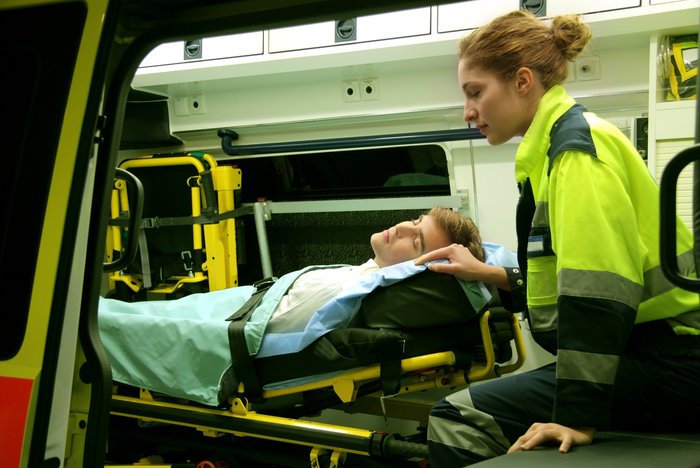
It's three a.m., and you have just been dispatched to a "pediatric difficulty breathing." As you rub the sleep from your eyes, you perform a quick mental review of the PALS protocol, just in case. Perhaps the child simply has a cold, and the parent has panicked. It happens all the time. But perhaps it's something more serious. You had better be ready for anything.
Emergency calls involving pediatric patients can be nerve-wracking events. And when they involve the respiratory tract, stress levels can soar. To be prepared, you must have all the necessary equipment: a cardiac monitor, O2 equipment, a pediatric bag, and, most importantly, your portable suction machine.
You never know when a pediatric call will turn into a respiratory emergency, so to ensure you are always prepared, we will review three common pediatric suction scenarios you will likely encounter.
CHOKING IN CHILDREN
Choking is one of the leading causes of unintentional death in infants. Just about anything can pose a threat. Johns Hopkins has put together a list of actions parents and caregivers can take to reduce the chance of choking among children. They include:
- Always supervise young children when eating, and keep children seated whenever they have food in their mouths.
- Identify choking hazards (ANY small object) and remove from reach of children.
- Keep toys age-appropriate and ensure they are not damaged.
- Be sure to remove hanging cords from window treatments to prevent strangulation.
- Discard plastic wrapping from toys or food.
Because food accounts for 50% of airway obstructions in children, here is a list Hopkins researchers have put together of the most common edible choking hazards:
- Hot dogs
- Nuts and seeds
- Chunks of meat, cheese, raw vegetables, or peanut butter
- Whole grapes
- Hard or stick candy
- Popcorn
- Chewing gum
When responding to a child choking (or any pediatric respiratory emergency!), be sure to include your portable suction unit with other ALS equipment. In the worst-case scenario, when the obstruction cannot be relieved, you will need suction for intubation and to control saliva/bleeding in the oral/nasal cavity.
CROUP
Croup, also known as laryngotracheobronchitis, is the most common cause of infectious airway obstruction in children. It typically affects children between six months and four years of age and is commonly caused by an influenza virus. Some of the signs and symptoms associated with croup include:
- Symptomatic for several days
- Low-grade fever
- Respiratory symptoms that progress from hoarseness to seal bark to stridor
- Nasal flaring
- Use of accessory muscles to breathe
- Tachypnea
- Low 02 saturation on pulse ox
The majority of field treatment for croup is supportive in nature. The child will need drug therapy (racemic epinephrine) and possible hospitalization, depending on the severity of their condition. In severe cases, intubation may be required, so be sure to have the portable suction unit ready.
EPIGLOTTITIS
Epiglottitis is a serious, life-threatening infection and a true airway emergency. It usually presents in children between two and eight but can strike at any age. Like croup, the most common causal agent is an influenza virus, but it can also have numerous infectious origins. Early recognition is key to respiratory management. The typical signs and symptoms include:
- Irritability—the patient may be reluctant to cooperate
- High fever
- Throat pain
- Obvious signs of respiratory distress
- Tripod position
- Excessive drooling
An easy way to remember the signs of epiglottitis is the "Four D's"—drooling, dyspnea, dysphagia, and dysphonia. A key point in treatment is to NOT attempt visualization of the airway. This will not only increase the patient's anxiety but may cause trauma to an already swollen airway.
As for the use of suction in the patient with epiglottitis, NEVER insert the suction catheter into the patient's mouth. If suction is utilized, simply hold the catheter below the lip of the patient to contain drooling. You can always place a towel beneath the patient's chin to catch the drool. Keep the patient in a position of comfort and minimize anxiety by using a calm, soothing approach.
Many pediatric respiratory emergencies can turn into suction scenarios. It is your responsibility to always be prepared. Here are a few important reminders:
- Check out your suction unit at the start of each shift to ensure it is operational.
- Inventory your suction accessories so you have the appropriate catheters on hand.
- Keep extra batteries on hand to avoid suction unit failure.
- Disinfect the unit after each use to avoid patient and rescuer contamination.
- Most importantly—BRING THE SUCTION UNIT WITH YOU ON EVERY CALL!!
Proper maintenance and unit readiness will ensure you have all the tools you need for that next pediatric suction scenario.
Editor's Note: This blog was originally published in October 2017. It has been re-published with additional up to date content.
















